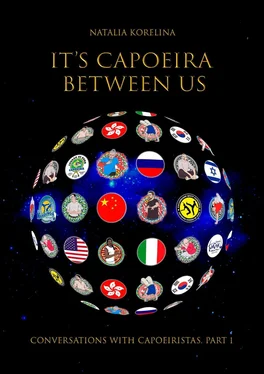The Beijing group is still functional, but Morena is now teaching in Iceland because her husband is from Iceland.
And then another important milestone for the Mandinga happened when one Taiwanese capoeirista came to my class. I think it was in 2009 or 2010, after class he indicated that he liked the energy and the vibe of that class; he said there were a few people in Taiwan and they had some issues with other groups there, as they didn’t like their styles and so he wanted to know about our group.
I told him it would be OK for him to come to our Batizado, so that he could speak with Mestre Marcelo. Three of them came to our Batizado, that would be the second or the third one, and they asked to join the group. Basically, we started to support them, so they could become a part of Mandinga group. I remember my first workshop there was in 2011, there were 9 of them in the class, all super beginners. I then left China in 2015, and when I returned in August of the same year, there were like 70 students; the capoeira level had risen dramatically. What they are doing there is an amazing job. People from all over Asia go to their events because they are super fun. They have nice vibe, good energy and most importantly, they are super good at capoeira.
They are also very into the design and marketing of gadgets and other paraphernalia, but their excellence in capoeira is undoubtedly their drawing card. They are really committed, I saw them in the beginning and every time I see them now, I see that they’ve grown and have done an amazing job.
Yet another milestone was when I became an instructor in 2012 and then I became professor in 2015; it was my Formatura 39 39 Formatura is a kind of «graduation» in capoeira, when senior students receive professor belts.
. Personally, I trained with Ido Portal, I invited him twice to Shanghai in 2011.
Curiosa: For a workshop?
Diego: Yes, he wasn’t famous yet, but he was known in the capoeira community. He gave a workshop in March and September of 2011. Let’s just say that from those workshops, we could see that he was at a different level.
He is a very interesting guy and I became his student, I did online coaching sessions and many workshops with him, and within 3 years he had helped me to completely alter my body, change my views about certain things and taught me how to protect the body. Further technical knowledge was also imparted by him to me.
Curiosa: When you came to China, what was the situation with capoeira and how has it changed?
Diego: When I moved to China in 2005, capoeira didn’t exist, nobody knew except for some Brazilian waiters that I met in some Brazilian restaurants. Pretty much no one knew about capoeira there. The only people who knew were those 10 people in the park.
What happened next. By 2008 or was it 2009, I don’t quite recall, we had 2 Chinese students. I’m not sure how they found out about capoeira, they were a husband and wife. They were our first Chinese students and they are still training with us today. She has also gotten her yellow belt now, after 10 years. 10 years I know seems like a long time, but we are very conservative.
But then in 2010, at Shanghai Expo, through some friends, we were given the opportunity to do 2 or 3 performances in the Brazilian Pavilion. Thus, capoeira was being advertised everywhere: in subways, in magazines etc. And that is how the Chinese people started to look at this Brazilian thing: a dance, a martial art, whatever. So, after 2010 we started to have more Chinese.
Curiosa: Were there mainly expats in your group?
Diego: We had only expats until 2009; after, we initially had 2 Chinese, now we have more Chinese and foreigners.
Curiosa: How did you manage with the language?
Diego: I went to Beijing for 6 months and I learned it there.
Curiosa: In what language did you offer your training?
Diego: At first, in English. I was giving classes in English most of the time until the majority of the class became Chinese, then I mainly used the Chinese language.
Curiosa: So how did you end up teaching capoeira back in Italy?
Diego: In 2015, I moved back to Italy, to Milan. I trained with Nadav for 6 months and then in September 2016 a couple students who had trained with me in Shanghai moved to Milan.
These students comprised of one Italian guy who was originally from Milan, he had been taking capoeira classes here with a group, but when he moved to Shanghai for a year, he ended up training with me.
The group here was closed and when he moved back, he said I should teach capoeira again because he didn’t want to go back to that group and he wanted to train “my” capoeira.
So, with me, my wife, him and his girlfriend at that time, there were four of us already, so I agreed to give it a try. I didn’t know where it would lead, for I hadn’t planned to continue teaching when I moved back to Italy.
Curiosa: You didn’t plan to teach?
Diego: No, I planned just to give training but not teaching, I didn’t want another big commitment. Because it’s a lot of work to be responsible for a group. It can be huge or it can be nothing if you don’t take it seriously.
Anyway, we started out few. Now the group has 20 persons; they are all very happy people, some of them are committed, some of them are less committed, but it’s fun nonetheless.
Curiosa: Nadav said that 2 of his students went to you?
Diego: Yes.
Curiosa: He said he would recommend you to his students if they can't train with him.
Diego: Yeah. It happens that some students might have difficulties with a group or with a teacher…
Curiosa: Or with a place or with a metro…
Diego: Whatever may be the case. It’s better that they continue training with someone else than stopping.
I mean in Shanghai, I had up to ten thousand students in ten years who have trained with me at least once. Everybody left Shanghai after a while (I am speaking about the expats) and for me the important thing is that they would continue to practice.
Curiosa: Is this a common experience with expats?
Diego: Yeah, it was tough. They were getting good and then they were leaving, they were getting good and then they were leaving. It’s frustrating but now…
Elisa (Diego’s wife): There were people who were coming and leaving but there was also a core group that was always there.
Curiosa: How did you both meet?
Diego: In Napoli, in the same university. We were not in the same class, but she was studying Chinese. After we met, in the same day, I said to her, “You know, tomorrow there will be a capoeira roda in the street.” So, I invited her to see a capoeira roda, but she didn’t go.
Elisa: I didn’t go.
Diego: And she didn’t go.
Elisa: I knew about capoeira, but I didn’t think of practicing.
Curiosa: How did the move to Shanghai come about?
Diego: I moved first, and then she moved a few months later and started capoeira a year later.
Elisa: At first, I was just going to the university classes to study Chinese but then I thought that I needed to do some sport. He was always going to the park, and I wanted to see what made it so interesting.
Curiosa: And now you are an instrutora?
Elisa: Yes.
Curiosa: Well done. Now back to Shanghai. Did you need to comply with an legal process to rent a space and teach?
Diego: No, in Shanghai you need nothing; you just teach. I paid the rent in cash at the time and I gave classes. Yeah, there was nothing to be done: no status, no registration, no association. Nothing, zero.
Читать дальше












